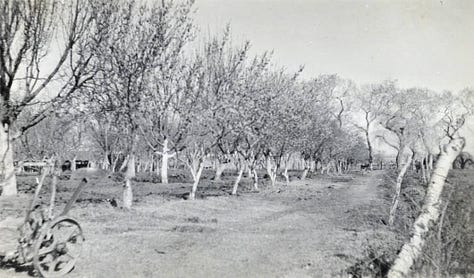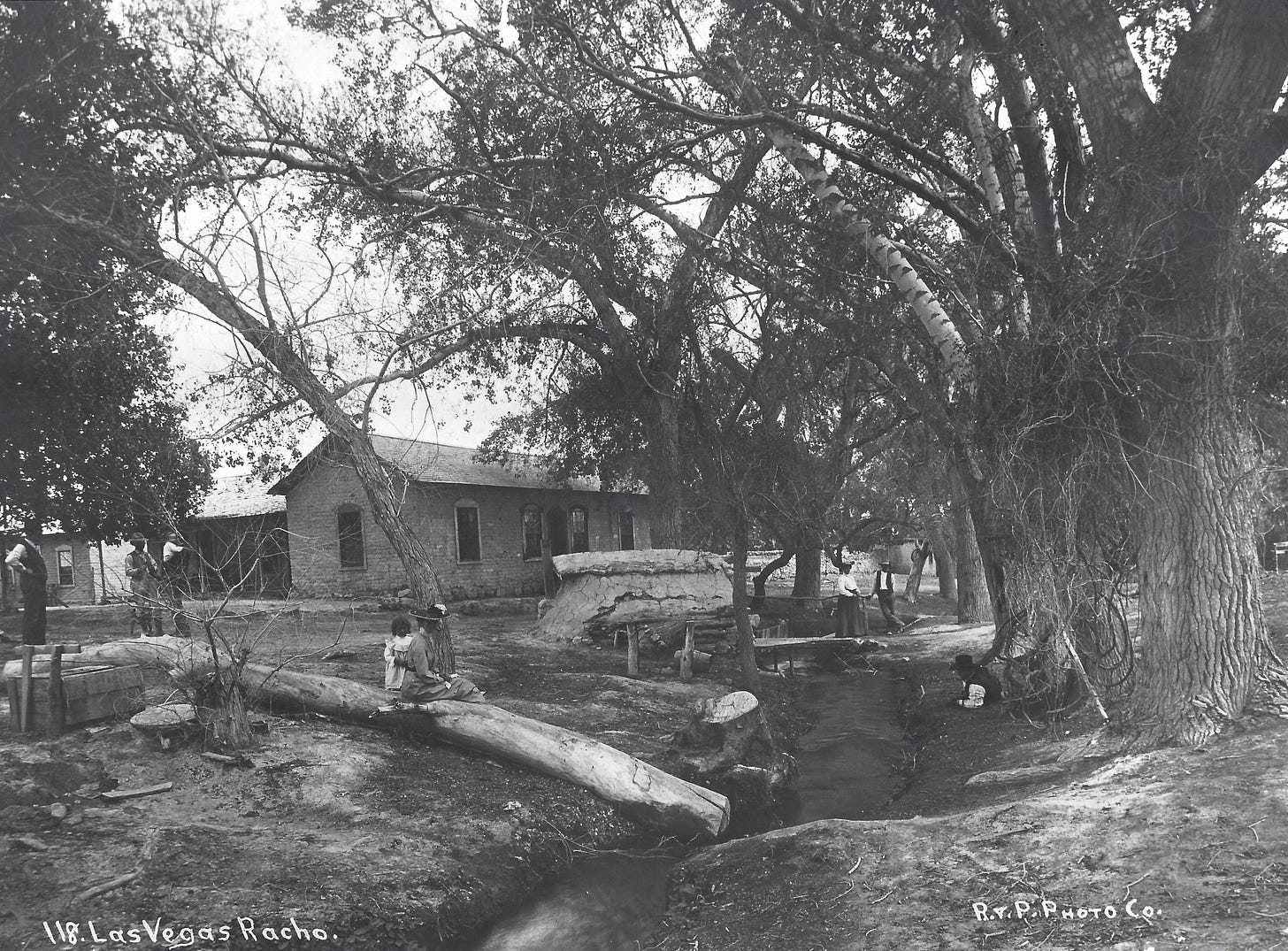An 1894 visit to Las Vegas, long before it was even a village
'Quintus Hopper of Nevada' series: When you hear 'Las Vegas' you instantly think of casinos and shows. But long before it was even a village, Las Vegas was an oasis, then became the Stewart Ranch.
Quintus Hopper of Nevada, published in January 2022, is a historical novel that follows the epic and peculiar life of a frontier newspaper typesetter. As part of my research I made extensive use of newspaper archives and, in this series, I’ll share some of my often surprising findings. Here are history, commentaries and contemporary newspaper articles as they relate to my latest novel. This time a look at Las Vegas before it was even a village. The oasis had been in important place for the Southern Paiute for centuries before the Spanish, then the Mormons came. In time, and after the Mormons abandoned it, it become an important ranch.
While Quintus spends his childhood in California, his adult life is all about Nevada. He spends the first half of it in northern Nevada, then journeys south. At the time he travels to the southern-most part of Nevada, there is preciously little there – and he likes it that way. There are the miners at Eldorado Canyon – but at that time, 1894, there is no notion of the region eventually becoming known as the ‘triangle of gold.’ Searchlight hasn’t been born, the railroad is nothing but a hope at that time – and the town of Las Vegas is a good ten years away from being founded.
The oasis that was Las Vegas (meaning ‘the meadows,’ named by the Spanish for its lush environment) was always cherished by the Southern Paiute. What followed, with the coming of the white man, is described in below Los Angeles Herald article. In the novel, Quintus becomes a regular visitor at the Las Vegas ranch, or Stewart ranch, and a good friend of Helen J. Stewart.
The railroad would indeed come. And Helen Stewart’s ranch was in the perfect place. She eventually sold her land and, with the coming of the railroad, the town of Las Vegas was born. In the novel, there is one chapter that deals, in a special way, with Helen Stewart’s profound connection with Las Vegas. But whether in the fiction of the novel or lived history, she will forever be known as the ‘first lady of Las Vegas,’ as she was there at the beginning, and instrumental in the town’s formative years.

September 22, 1894
Los Angeles Herald, Los Angeles
IT IS A VERY FINE COUNTRY.
What a Writer Says of the Las Vegas Valley.
Ben C. Jordan Gives a Glowing Description of It.
The Land Through Which the Southern Nevada Railroad Will Run – A Little of Its History.
Special correspondence to the HERALD.
LAS VEGAS RANCH, Sept. 15.
In the year 1830 a party of Spanish monks came up the Colorado river, their object being to establish missions. After traveling for some time they left the river and traveled inland 25 miles, when they came upon a spot where they chose to locate, and their action in this matter was an exemplification of the fact that the judgment of the Spanish monks regarding climate and fertility of soil was something marvelous. The wonderful results which they obtained in California were fully equaled at the point of which mention has just been made, and it really seems as if they must have been inspired.
This party gave the name of Las Vegas (the meadows) to this place, and it was rightly named. Standing upon a little swell just south of the ranch house and looking off to the east one sees the green bottom lands stretching away for miles toward the southeast, to the foothills, being dotted here and there with clumps of tall, graceful cottonwoods and thick groves of mesquites, while through its whole length runs a brook, the rippling of which seems to be a joyous laughter over the conquering of the desert and the making of it “to rejoice and blossom as the rose.”
Many years after the monks left Mormon missionaries entered, and they, too, saw the exceptional advantages of this valley as a colony site, and proceeded to establish one. Difficulties without number arose. Indians harassed them, sickness came, supplies failed to arrive, but nevertheless, with their accustomed persistence and energy, they continued until they had a thriving colony of 35 families. This was about the year 1855, as the first to enter was Captain Hunt, who made the first tracks through to Los Angeles in 1849. In 1850 the first emigrant party went through to San Bernardino. In 1855 the first freight trains made the trip from Los Angeles to Salt Lake, and it was about this time that the first families located here.
The colony was successful and built a church and school house and a smelter for refining the ore from the famous Potosi mine. They made all plans for the establishment of happy and beautiful homes and hoped to live here in peace, and when the time came for them to leave the earth, they fondly hoped to be laid to rest in the quiet valley, where their families and friends could with loving tenderness make beautiful their last resting places.
But it was only a dream. They were suddenly called upon to realize the stern realities of life by the order that came to them from Brigham Young in 1857, calling them home at once because of the fact that the relations between the United States government and the Mormon church were strained, and war seemed imminent. They left their farming implements and household utensils behind, some of them buried. They left their newly planted orchards and vineyards and groves of cottonwoods to desolation and loneliness.
Years rolled by and brought many changes, but Las Vegas valley still remained deserted until about 1865, when a party of gentlemen, composed of O. D. Gass, Salisbury, Knapp, Howell and Wilson took possession of the ranch. They retained it in common for a number of years, when Mr. Gass brought out the shares of the others, but the burden was too heavy for him and he failed, and in 1879 the property came into the hands of Archibald Stewart. In 1884 Mr. Steward died, leaving a wife, still a young woman, with five small children, the oldest being 10 years of age. Since the death of her husband, Mrs. Stewart has managed the entire business, and has shown herself to be a remarkable woman.
The ranch has improved steadily, orchards and vineyards being put out, buildings erected and the size of the ranch has increased from 640 acres to 1880 acres. This has required years of unceasing toil and planning, and proves that Mrs. Stewart is a woman of great ability and energy.
Las Vegas ranch is superior to any ranch in Southern Nevada, the soil being remarkably fertile, while the climate is such that fruit ripens earlier than in any other valley of the state. This was conclusively proved at the midwinter fair, where fruit from this ranch was on exhibition two weeks before similar fruit arrived from any locality. And besides all this it is a beautiful place at which to live, there being less objectionable features than anywhere else in the world I believe. At this time of the year the weather is simply perfect; calm, sunny days, so quiet that it would seem as though trouble were entirely out of place in this world; followed by nights so cool and comfortable that the most restless person cannot help sleeping.
There seems to be, at the present time, considerable interest taken in Las Vegas valley by Los Angeles people, and probably an attempt will soon be made to find artesian water. That such an attempt will be successful there is very little room for doubt as everything indicates an abundance of it. When the railroad once touches the valley I prophesy that it will be more quickly settled than any other valley in the southwest ever was, for it will then possess a combination of advantages that are unequaled as far as I know.
Ben C. Jordan.


















